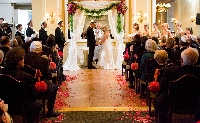
Jewish wedding traditions make your special day even more meaningful
Congratulations on your upcoming wedding! It’s such an exciting time, with so many choices to make.
If you’re hoping to incorporate Jewish tradition when you marry in your ceremony, you’ve come to the right place. I’ve created an overview of some of the more common (and some newer) rituals and practices for your Jewish wedding.
The Ketubah
Also known as a Jewish wedding contract, the traditional Ketubah (Ketubot, in the plural) is at its core a document describing the groom’s obligations towards the bride, both during the marriage and in the event of a divorce.
Since the late Middle Ages, these documents have been decorated with lovely art work and beautiful calligraphy. The documents were signed by the bride and groom, and two male witnesses, and were often framed and displayed in the home.
The ketubah continues to be a part of most Jewish weddings. But because many modern couples are not comfortable with the patriarchal language of Orthodox ketubot, today’s Jewish weddings are often celebrated with the signing of a modern Ketubah which describes the bride and groom’s hope for the marriage, as well as responsibilities towards one another. These documents are signed by the bride and groom, along with two or more witnesses of their choosing of either gender.
The Chuppah
Jewish weddings usually take place under a canopy, known as a Chuppah. The Chuppah represents the new family being formed during the ceremony, as well as the new dwelling they will inhabit.
Traditionally, a Chuppah was made by a Tallit (prayer shaw) held over the couple. But any non-permanent cloth suspended or held over a couple will do. Some couples choose hand-painted Chuppah cloths, then display them as art work in their new home. Others use beautiful lace or woven tablecloths, quilts or silk fabric. And some blended families are even choosing to create one, allowing each family member to paint or draw or otherwise decorate a portion of the cloth.
The Veiling (Bedecken)
Dating back to the case of mistaken identity with Rachel and Leah in the Bible, there is a tradition of the groom placing the wedding veil over his bride’s face just before the wedding.
Some people say this is so he knows that he’s marrying the right woman. Others say it’s a sign of closing her off to all men except himself. This tradition had all but disappeared except in Orthodox circles, but it’s made a comeback in recent years — but with a twist.
In my own wedding I placed my soon-to-be-husband’s white wedding kippah on his head, then he placed the veil over my face, symbolizing our mutual intimacy and new status as a couple.
The Circling
Another element of a traditional Jewish wedding is when the bride walks around her groom seven times. The reasons given are many, from the seven days of creation as a parallel to the new life the couple is creating, to the seven mentions of a man taking a wife in the Torah. Some have even suggested it’s a last chance to check out the groom, and decide for sure if she want to marry him!
Modern couples might include the tradition, but many vary it to include three circles for the bride, three for the groom, and three together.
The Shared Wine (Kiddushin)
Wine plays a critical role in most Jewish rituals, and the wedding is no exception. During the ceremony, the Rabbi or Cantor will say a blessing on the wine, and then the bride and groom will each sip from the cup.
There is no specific requirement for the cup, but most Jewish couples do select an especially beautiful Kiddish cup for this part of the wedding ritual. The cup can then be used for Shabbat dinners and holidays as a reminder of their wedding day.
The Glass
Even people who know nothing about Jewish wedding traditions usually know about the dramatic smashing of the glass at the end of the ceremony.
Any easy-to-break glass will work, as it is wrapped in a napkin or cloth before the ceremony. At the conclusion of the wedding, the wrapped glass is placed on the floor, and the groom smashes it with all his might. The guests usually respond with a hearty “Mozel Tov!”, and the wedding is considered complete.
The reason for the shattered glass is not known. Some say it is to remember the destruction of the Temple, while some to ward off evil spirits who might interfere if the whole event was too happy. Others say it is so that the marriage will last as long as it would take to reassemble all the pieces of that glass into a perfect whole.
~
The Yihud (Alone Together)
It’s a tradition in some circles that immediately after the ceremony, the bride and groom spend some time together alone in a private room, where they can catch their breath and share a small meal in honor of their new status as a married couple.
In other traditions, this time is scheduled for immediately after the wedding supper. In either case, the meaning was probably more dramatic in times past when it was unlikely that the two had ever been alone together before this moment. But after the stress of wedding planning and the ceremony itself, it remains a welcome respite for many couple even today.

